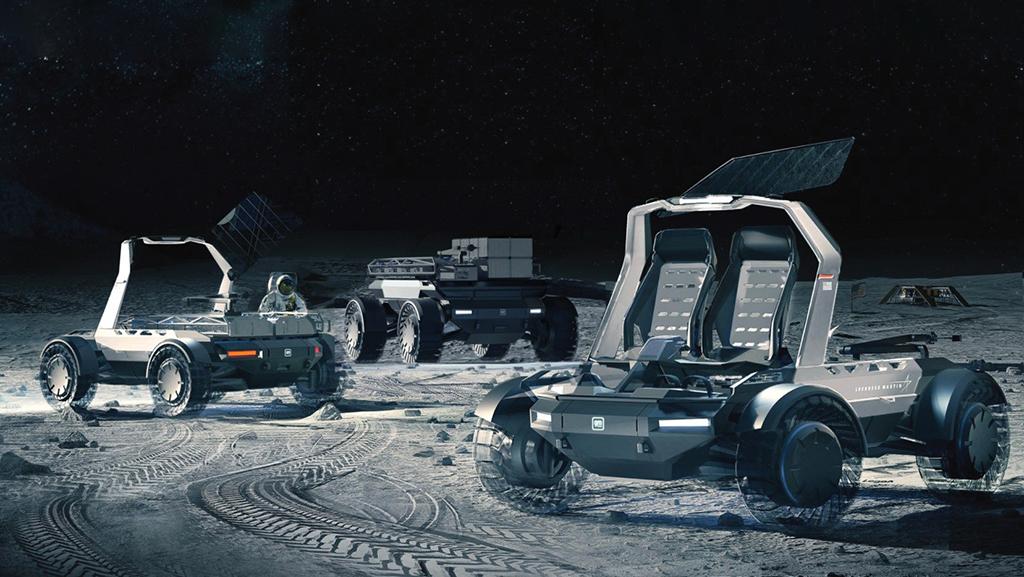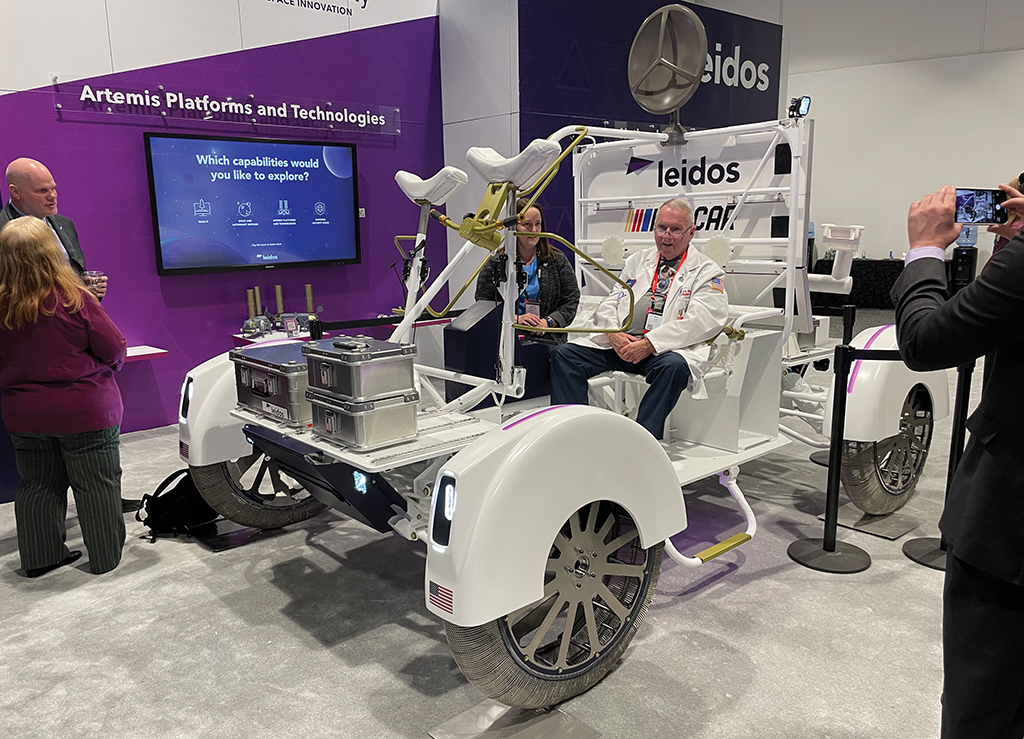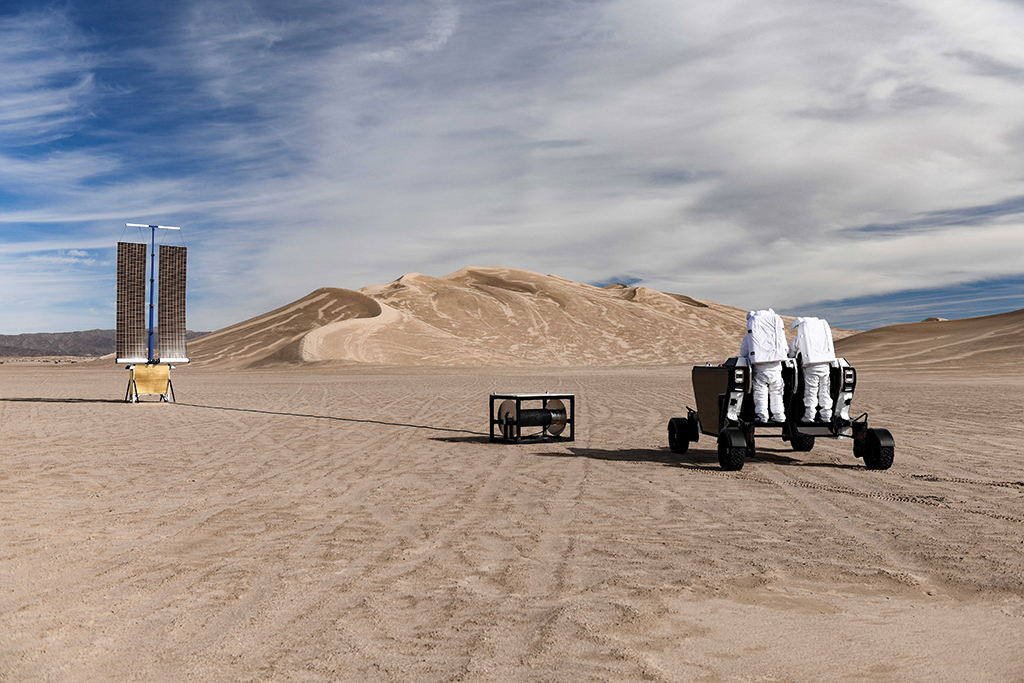
Lockheed Martin’s rover design uses GM battery technology.
Following its successful approach to commercializing crew access to low Earth orbit and sending payloads to the Moon, NASA has opted to contract lunar rovers as a service from industry rather than owning them.
As the agency closes in on releasing a final request for proposals for a lunar terrain vehicle (LTV) service on the Moon, new details of several designs are emerging. The latest group to show its hand is Dynetics, a Leidos company, which unveiled a prototype rover at the 2023 Space Symposium in Colorado Springs.
- Leidos LTV is backed by Nascar
- Venturi Astrolab FLEX rover is planned for a 2026 Moon landing
Developed with Dynetics and promoted in partnership with U.S. motor racing organization Nascar, the vehicle may outwardly resemble the rovers of the Apollo era but differs substantially in detail and technology. For one, it is powered by a combination of solar and battery systems.
NASA is widely expected to issue its LTV request for proposals in May and Leidos will likely submit its vehicle bid in July. The contract award is scheduled to occur by year-end, with initial lunar operations envisaged in 2028.

Design features of the Leidos vehicle include a top speed of 15 kph (9 mph) and a range “in excess” of 20 km (12 mi.). The vehicle has an advanced thermal management system to cope with the extreme temperature ranges expected during NASA’s Artemis missions targeting the lunar south pole area.
NASA’s Artemis LTV requirements also include the ability to cover a range of hundreds of miles per year and access diverse locations for science missions, resource prospecting and exploration.The LTV must be capable of remote operation and be available for other commercial uses when not carrying out NASA research and operations.
“We have entered a new Moon race with a partner that’s really good at going fast,” says Steve Cook, president of Leidos’ Dynetics Group. “I think ‘LTV’ is going to become as common as ‘SUV’ in the future because we are opening up a new frontier, and this is Day 1 of us announcing what that new frontier is going to look like.”
Leidos has already submitted a bid for the Human Landing System Sustaining Lunar Development contract, a key component of NASA’s efforts to establish a sustainable presence on the Moon. Leidos also is working on the Universal Stage Adapter for NASA, an element that would enable the transport of large payloads, including the rover it unveiled.
The Leidos LTV features four large, flexible, wire-mesh wheels with stiff inner frames to prevent overdeflection. Lights are integrated into the front wheel arches, which pivot with the steering to illuminate terrain directly in front of the vehicle as it turns. The large arches are designed to turn with the wheels to prevent excess moondust from being kicked up over the vehicle.
“The vehicle is built around the crew,” Matt Doude, business development lead and space systems program manager for the Dynetics LTV, told Aviation Week at the LTV unveiling on April 18. “We started with a model of male and female suited crewmembers and designed around them to maximize effectiveness and time on task while on the surface.”
Doude said the company expects to “spend the next 12 months or so getting to the preliminary design review, and we’ll have a vehicle operational when the Artemis 5 crew arrives on the surface, which is notionally 2027-28.” He added that studies of various launch and landing system options are underway. “We’re in discussions with a number of lander providers and we like to remain lander-agnostic—we can deliver the vehicle with a number of options,” he said.

Competition for the next lunar rover is heating up, with another contender, Venturi Astrolab, displaying its multipurpose Flexible Logistics and Exploration (FLEX) rover for the first time at the Space Symposium. The company recently signed an agreement with SpaceX to transport the rover to the Moon on a Starship flight as early as mid-2026. The mission, which is planned to include other customer payloads up to 1,000 kg (2,200 lb.), is to be a ride-share payload on a Starship mission destined for the south polar region.
“[FLEX’s] versatility fundamentally comes from its modular payload concept,” Venturi Astrolab founder and CEO Jaret Matthews told Aviation Week at the Space Symposium. “Unlike rovers of the past, where they land with a fixed set of instruments and equipment that they have for the duration of life, FLEX has a modular payload concept that can have cargo or instruments come and go. And so over time, as new cargo is landed on the Moon, the idea is to serve as wide an array of use cases and customers as possible.”
The FLEX is built around an inverted U-shaped chassis resembling a mobile cargo container crane. The vehicle frame provides 3 m3 (105 ft.3) of volume and can hold up to 1,500 kg. “You can fit about 30 of those on a single SpaceX Starship, so we’ve approached this problem the way you would approach supply chain logistics on Earth,” Matthews said. “In that system, you have big ships crossing the ocean, full of thousands of shipping containers. Then at the port you have trucks and trains to distribute cargo. We were inspired by that, and we’re taking an idea that works well on Earth and doing it on the Moon. For lunar logistics, we want to be the last-mile solution, but carrying crew is also one of the things that we want to do.”
Lockheed Martin is developing an LTV dubbed the Lunar Mobility Vehicle (LMV) in partnership with General Motors and Lunar Outpost. The vehicle is being designed to operate with or without humans and to preposition itself autonomously near a landing site prior to the arrival of the crew. Lockheed says the LMV also would be able to be operated remotely from the Human Landing System or the orbiting lunar Gateway.
The Lockheed rover is being designed to survive and even operate during the two-week-long lunar night that sees temperatures as cold as -280F and in daytime temperatures of 260F. The power system is planned to leverage GM’s Ultium cell technology, which relies on a nickel-cobalt-manganese-aluminum chemistry and requires 70% less cobalt than the cells used in the car company’s Bolt EV. “We’re currently doing a lot of development on the motors and electrical systems,” says Kirk Shireman, vice president of lunar exploration campaigns at Lockheed Martin.
Meanwhile, Northrop Grumman also has teamed for the LTV contest with AVL, Intuitive Machines and Michelin. Another team includes Teledyne Brown Engineering, Sierra Space and Nissan North America.
Editor's note: This article was updated to clarify Lunar Outpost's partnership on the LMV.
